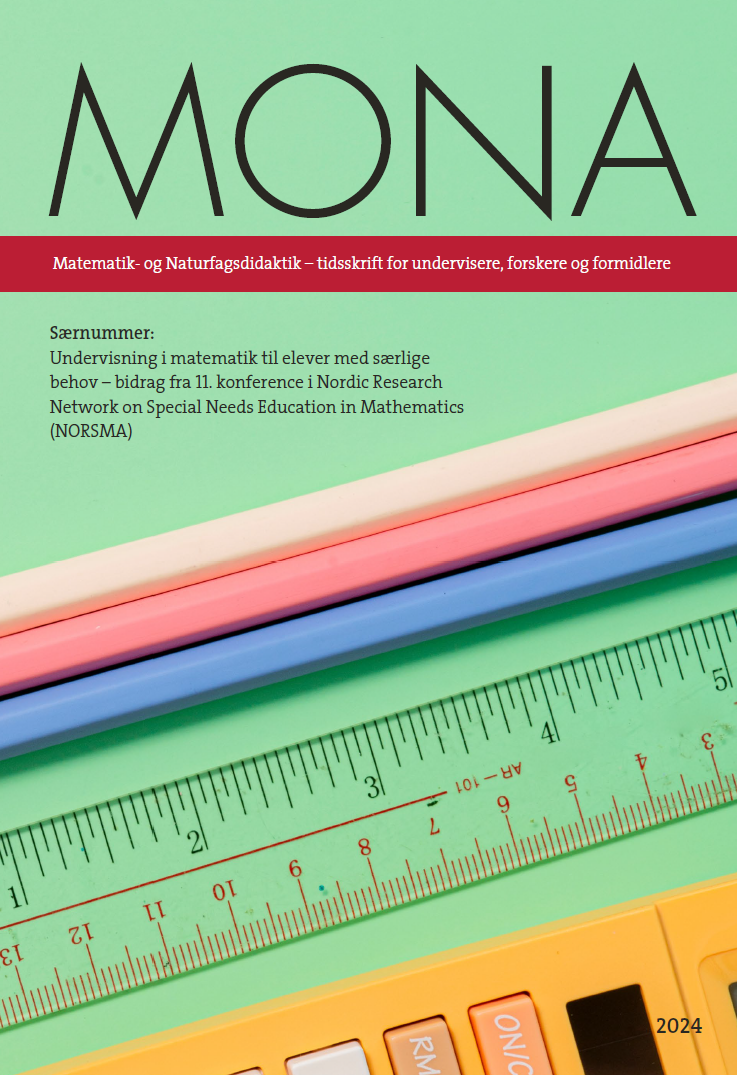Resumé
Artikeln utgår ifrån kunskapsområdet specifika matematiksvårigheter och reflekterar och problematiserar hinder och möjligheter i relation till tvärvetenskaplig samverkan mellan utredningspraktik och matematikundervisning i en svensk kontext. De hinder och möjligheter som framträder visar på ett behov av en tvärvetenskaplig samverkan med förståelse för olika perspektiv. Parallellt finns även ett behov av ett förbättrat kunskapsläge på svensk nationell, regional och kommunal nivå inom vård och skola avseende specifika matematiksvårigheter för att kunna erbjuda adekvat stöd. Artikeln synliggör kunskapsbristen kring pedagogiska och didaktiska anpassningar grundat i förebyggande insatser som kan stödja elevernas hälsa och välmående.
Referencer
Agostini, F., Zoccolotti, P., & Casagrande, M. (2022). Domain-general cognitive skills in children with mathematical difficulties and dyscalculia: A systematic review of the literature. Brain Sciences, 12(2), 239.
AIRIPA and AID (2012). Agreement document. Diagnosis of dyscalculia.
Almenberg, J., & Widmark, O. (2011). Räknefärdighet och finansiell förmåga. Finansinspektionen.
American Psychiatric Association. (2022). Diagnostic and statistical manual of mental disorders (5th ed., textrev.).https://doi.org/10.1176/appi.books.9780890425787
Andersson, U., & Östergren, R. (2012). Number magnitude processing and basic cognitive functions in children with mathematical learning disabilities. Learning and Individual Differences 22(6), 701‑714.
Butterworth, B., Varma, S., & Laurillard, D. (2011). Dyscalculia – From Brain to Education. Science 332(6033), 1049‑1053.
Butterworth, B. (2000). Den matematiska människan. Wahlström & Widstrand.
Butterworth, B. (2018). The implications for education of an innate numerosity-processing mechanism. Philosophical Transactions of the Royal Society B: Biological Sciences, 373(1740), 20170118.
Bynner, J., & Parsons, S. (1997). Does Numeracy Matter? Evidence from the National Child Development Study on the Impact of Poor Numeracy on Adult Life. The Basic Skills Agency.
Dalvang, T., & Lunde, O. (2006). Med kompass mot mestring – et didaktisk perspektiv på matematikkvansker. NOMAD – Nordic Studies in Mathematics Education, 11(4), 37‑64.
Danderyds sjukhus (2023). Intern statistik. Logopedkliniken.
Dowker, A. (2019). Individual differences in arithmetic: Implications for psychology, neuroscience and education. Routledge.
Gardesten, M. (2023). How Co-Teaching May Contribute to Inclusion in Mathematics Education: A Systematic Literature Review. Education Sciences, 13(7), 677.
Gifford, S. (2006). Dyscalculia: Myths and models. Research in Mathematics Education 8, 35‑51.
Haberstroh, S., & Schulte-Körne, G. (2019). The diagnosis and treatment of dyscalculia. Deutsches Ärtzeblatt International 116, 107‑114.
Karlsson, I. (2019). Elever i matematiksvårigheter: Lärare och elever om låga prestationer i matematik. [PhD thesis]. Lunds universitet.
Kißler, C., Schwenk, C., & Kuhn, J-T. (2021). Two Dyscalculia Subtypes with Similar, Low Comorbidity Profiles: A Mixture Model Analysis. Frontiers in Psychology 12, 589506.
Klapp, A. (2017). Bedömning, betyg och lärande. Studentlitteratur.
Košč, L. (1974). Developmental dyscalculia. Journal of learning disabilities, 7(3), 164‑177.
Kucian, K. & von Aster, M. (2015). Developmental dyscalculia. European Journal of Pediatrics 174, 1‑13
Lewis, K. E., & Lynn, D. M. (2018). Access through compensation: Emancipatory view of a mathematics learning disability. Cognition and Instruction, 36(4), 424‑459.
Magne, O. (2006). Historical aspects on special education in mathematics. Nordic Studies in Mathematics Education, 11(4), 7‑35.
Mazzocco. M. (2007). Defining and Differentiating Mathematical Learning Disabilities and Difficulties. In D. Berch & M. Mazzocco (Eds.), Why is Math So Hard for Some Children? The nature and origins of mathematical learning difficulties and disabilities (pp. 29‑47). Brookes.
Morsanyi, K., van Bers, B., McCormack, T., McGourty, J. (2018). The prevalence of specific learning disorder in mathematics and comorbidity with other developmental disorders in primary school-age children. British Journal of Psychology 109(4), 917‑940.
Nelson, G., & Powell, S. R. (2018). A systematic review of longitudinal studies of mathematics difficulty. Journal of Learning Disabilities, 51(6), 523‑539.
Pedrotty Bryant, D. (2005). Commentary on early identification and intervention for students with mathematics difficulties. Journal of Learning Disabilities, 38(4), 340‑345.
Price, G. R., & Ansari, D. (2013). Dyscalculia: Characteristics, Causes and Treatments. Numeracy, 6(1), 2.
Rapin, I. (2016). Dyscalculia and the Calculating Brain. (2016). Pediatric, 61, 11‑20. ISSN 0887‑8994.
Roos, H. (2023). Students’ voices of inclusion in mathematics education. Educational Studies in Mathematics 113, 229‑249. https://doi.org/10.1007/s10649-023-10213-4 https://link.springer. com/article/10.1007/s10649-023-10213-4
Roos, H. (2019). The meaning of inclusion in student talk: Inclusion as a topic when students talk about learning and teaching in mathematics. [PhD thesis]. Linnaeus University: Växjö.
Roos, H., & Gadler, U. (2018). Kompetensens betydelse i det didaktiska mötet – en modell för analys av möjligheter att erbjuda varje elev likvärdig utbildning enligt skolans uppdrag. Pedagogisk forskning i Sverige, 23, 290‑307.
Santos, F. H. (2020). Interventions for Children with Developmental Dyscalculia: Parents, teachers and neuropsychologists working together. In Understanding Dyscalculia (pp. 65‑93). Routledge.
Scherer, P., Beswick, K., DeBlois, L., Healy, L. & Opitz, E. (2016). Assistance of students with mathematical learning difficulties: how can research support practice? ZDM Matematics Education, 48, 633‑649.
Scherer, P., Gaidoschik, M., Moraová, H., Roos, H., & Ulovec, A. (2023). An introduction to TWG25: Inclusive mathematics education – challenges for students with special needs. In P. Drijvers, C. Csapodi, H. Palmér, K. Gosztonyi, E. Kónya (Eds.), Proceedings of the Thirteenth Congress of the European Society for Research in Mathematics Education (CERME13) (pp. 4524‑4531). Alfréd Rényi Institute of Mathematics and ERME.
Semeraro, C., Coppola, G., Taurino, A., & Cassibba, R. (2020). Understanding the impact of diagnosis. In Understanding Dyscalculia. Routledge.
Shalev, R. S. (2004). Developmental dyscalculia. Journal of child neurology 19(10), 65‑771. SFS (2010:800). Skollagen (2016). Norstedts Juridik.
Sjöberg, G. (2006). Om det inte är dyskalkyli – vad är det då? En multimetodstudie av elever i matematikproblem ur ett longitudinellt perspektiv. [PhD thesis]. Umeå universitet.
Skolverket. (2023). PISA 2022. https://www.skolverket.se/publikationer?id=12177
van Luit, J. E. (2019). Diagnostics of dyscalculia. In International Handbook of Mathematical Learning Difficulties (pp. 653‑668). Springer.
van Luit, J. E., Bloemert, J., Ganzinga, E. G., and Mönch, M. E. (2014). Protocol Dyscalculie: Diagnostiek voor gedragsdeskundigen (2e herziene druk) [Protocol Dyscalculia: Diagnostics for Behaviour Professionals, 2nd Edn. Graviant.
Vogel, S. E, & De Smedt, B. (2021). Developmental brain dynamics of numerical and arithmetic abilities. npj Sci.Learn. 6, 22.
Von Aster, M. G., & Shalev, R. S. (2007). Number development and developmental dyscalculia. Developmental medicine & child neurology, 49(11), 868‑873.
World Health Organization. (2019). ICD-11: International classification of diseases (11th revision). Retrieved from https://icd.who.int/ World Health Organization.

